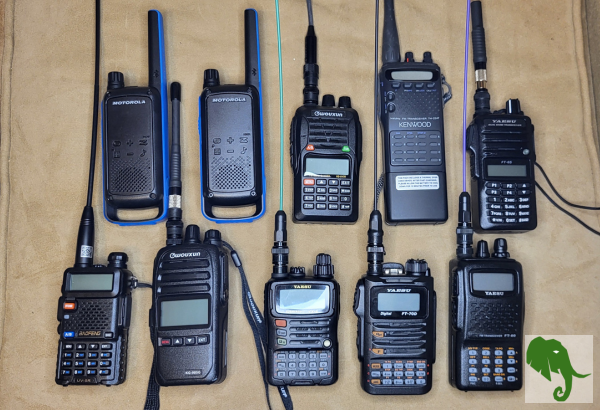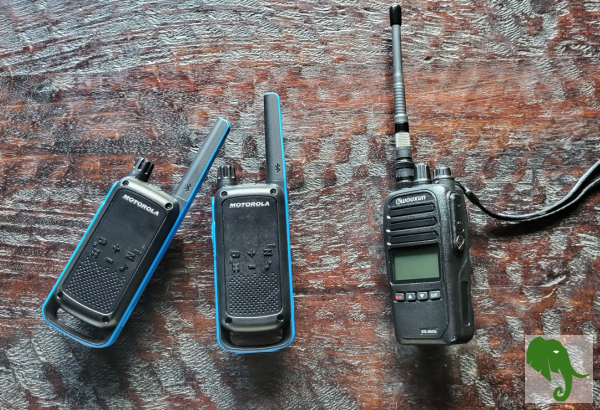
What if a means of communication that we are all dependent upon is no longer available? In the spirit of becoming better prepared, have you ever considered where a radio fits into your preparedness or emergency plan? No, I’m not talking about the types of radios we all use to listen to music, news, talk shows, or weather being broadcast. I am talking about various types of radios capable of transceiving (both transmitting and receiving), enabling us to stay in contact with others in our group(s) or even outside of our group(s). Radios that not only allow a convenient, dare I say cool, means of communicating with others; but radios that could support us in the case of an emergency as an alternative means of communication.
Why Radio
Have you ever thought about what you might do for communication if telephone landlines, the internet, or cellular networks went down? Or maybe you’re planning a trip or an activity with the fam or some other group where it would just be nice to stay in touch with everyone and not have to try to call or text every time you needed something. What if you got separated from your crew for some reason? Wouldn’t it be nice not having to worry about calls connecting or having to wait on a response back to that last text you sent? What if you are just wanting to do a simple check-in to find out where everyone is or when and where the group wants to meet up? Or maybe you are where you just cannot get reliable cell phone service, even when you are standing on one foot and holding your tongue just so. Have you thought through any of these sorts of scenarios? What’s your plan?
Enter radios. And while you may not be familiar with all the different types of radios available in the world for your consideration, that’s quite all right; because I am going to narrow it down to the ones I think are likely most relevant and provide an overview for each. We may talk more about radio terms and concepts, as well as do a bit of a deeper dive on a couple of the options discussed here, in future posts.
Types of Radios
While we are not going to talk about every type of radio, we are going to walk you through high-level overviews of the radio types I feel like you are most likely to consider for your preparedness and emergency needs.
FRS (Family Radio Service)
FRS is what is considered one of the most basic of options, an entry to radio usage. These radios are, to me, the quintessential “walkie-talkie” supporting basic two-way radio-to-radio communication for families and groups. They are usually the ones you’ll find in the blister/bubble packs in big box stores. Some facts to weigh in the mix:
| Licensing: | N/A |
| Test for license: | N/A |
| Call-sign: | N/A |
| Radio sizes: | Handheld only |
| Frequencies: | 22 channelized UHF frequencies, 462-467 MHz Range |
| Power: | 2 Watts |
| Antenna: | Fixed only |
| Repeaters: | N/A |
| Range: | ~1-2 miles (depending on environment, maybe much less) |
| Price: | $20 – $100+ (usually sold in 2-packs or more) |
FRS radios are basic and mostly inexpensive, but do not expect crazy range with them unless you happen to be in the most ideal of conditions. This is due to their limited power, no use of repeaters and no option for different antennas. Pay a little more to get better radios. And admittedly, FRS is probably not the best option for emergencies because its range and overall capabilities are somewhat limited. With that said, they can be a decent choice for staying connected when at an airshow or amusement park, etc., as examples.
GMRS (General Mobile Radio Service)
GMRS is still somewhat basic but you get some added benefits when you step up to GMRS. A radio choice for family, groups, and even some businesses. Some details to consider:
| Licensing: | $35 to FCC for 10-year license |
| Test for license: | N/A |
| Call-sign: | Yes, with license |
| Radio sizes: | Portable (Handheld) and Mobile |
| Frequencies: | 30 channelized UHF frequencies, 462-467 MHz Range, including 8 specifically for GMRS repeaters |
| Power: | 5 Watts for handhelds and 50 Watts for mobile |
| Antenna: | Can swap out factory antenna on handhelds and opt for various mobile antenna options |
| Repeaters: | Yes |
| Range: | ~1-2 miles (depending on environment, maybe much less, or much more if you can get on a GMRS repeater) |
| Price: | $25 – $200 for handhelds – $100 – $400+ for mobiles |
GMRS radios are a definite step up from FRS with the ability to upgrade/change out antennas, use of GMRS repeaters, and mobile units offering more power. Additionally, since they use the same frequencies as FRS, you can talk to FRS radios and vice versa. Your range will ultimately vary based on your environment and whether you have any GMRS repeaters in your area. Plan on experimenting with antennas.
Amateur (HAM) Radio
HAM radio is by far the most complex of the options; but it does not have to be. You can go as far as you want to with it or keep it simple as you like. For most preparedness or emergency purposes, a simple approach is best and likely would be all you would need to do, at least when getting started. We will likely talk more about amateur radio in a future post. For now, we start with the following points:
| Licensing: | $35 to FCC for 10-year license |
| Test for license: | Yes (35 questions pulled from pool of ~400) |
| Call-sign: | Yes, with license |
| Current license levels: | Technician, General, and Amateur Extra |
| Radio sizes: | Portable (Handheld Transceiver (HT)), Mobile, and Base |
| Frequencies: | Based on license level. Technician gets you 2M/VHF and 70cm/UHF. General will open you up to HF, etc. |
| Power: | 5 Watts for Handheld, 50 Watts for mobile, and upwards of 100 Watts for Base units |
| Antenna: | Many options |
| Repeaters: | Yes |
| Range: | ~1 mile to the other side of the world (depending on environment, frequencies utilized, power, and antenna) |
| Price: | $17 – $1000s (depends on whether a portable, mobile, or base unit and the features) |
Amateur (HAM) radio is the most versatile of these radio types, offering the most in capabilities and flexibility. There is a test for each license level you pursue. Radio performance is still based on power and antenna capabilities for the frequencies you use. And if you get and decide to just stick with the Technician license, that’s OK because there are way more HAM repeaters than GMRS repeaters in most places. To me, HAM radio is the best overall option whether you get into it as a hobby or an alternate means of communication (alt comms) in an emergency or when things go sideways.
Resources
- FCC – Family Radio Service (FRS)
- FCC – General Mobile Radio Service (GMRS)
- FCC – Amateur Radio Service
Conclusion
I know I did not go into a deep dive on any of the options I presented. This was intentional, as I just wanted to get the options out on the table with some of the basic points for you to start considering.
And yes, I also know I intentionally left out good ol’ CB (Citizen’s Band (Radio Service)) and MURS (Multi- Use Radio Service), along with some others. However, I have covered what I feel are likely the best contenders allowing the most flexibility and accessibility for emergency needs or otherwise. And in the spirit of transparency, these 3 are the options I am personally most familiar with. The world of radio can be vast and can get complicated; so I wanted to keep it somewhat condensed here to help keep things focused. Don’t worry. We will explain more in time.
If you are just starting to consider your options and/or you are new to radio, you are not alone. I too am still somewhat new to HAM radio, only having passed my Technician’s license exam around last April. I also have and use both FRS and GMRS radios. I’m still learning; and I wanted to start sharing some of the information I have learned along the way in hopes of helping you as you consider how radio can help you with your preparedness and emergency planning and initiatives including what radio type might be right for your alternative means of communication.
Stay tuned for future radio-focused posts from us. Leave us any questions in the comments section below; and we’ll work to get them answered.
Related Content

Understanding Basic Radio Terminology and Categories
Whether you’re interested in emergency preparedness, outdoor recreation, keeping a group connected, or just want to be able to communicate when cell networks are unavailable …

Read other OwnGuard Solutions blog posts
Read our other posts centered around being safer and better prepared.

